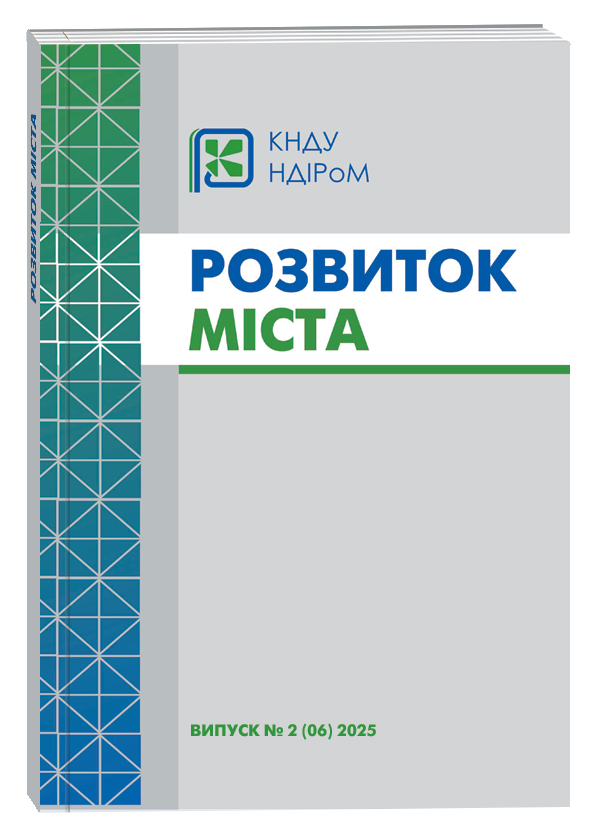PROBLEMS OF HARMONIZATION OF TAX SYSTEMS OF EUROPEAN UNION COUNTRIES
DOI:
https://doi.org/10.32782/city-development.2025.2-21Keywords:
harmonization, tax system, VAT, taxation, tax competition, European Union, corporate taxAbstract
Harmonization of tax systems of the European Union countries is an important condition for the functioning of the single market and ensuring fair competition between member states. The author examines the main problems that hinder harmonization. These include uneven socio-economic development of member states, differences in budget structure and sources of fiscal revenues, political sensitivity of tax policy issues, limited EU mandate in the field of direct taxation, differences in fiscal competitiveness of EU member states. The degree of harmonization of indirect taxation, in particular VAT and excise duties, and the difficulties of harmonizing direct taxation, in particular corporate tax, have been analyzed. Modern EU initiatives to combat tax competition and tax evasion in particular BEPS, ATAD and the introduction of a minimum corporate tax have been considered in the article. The tax burden in EU countries in 2021–2023 has been studied. Special attention has been focused on the need to strengthen tax policy coordination to achieve balanced harmonization that takes into account both integration goals and national interests. Digitalization of tax administration also strengthens the analytical capabilities of state institutions, reduces the level of VAT fraud, promotes the unification of data exchange formats and the development of interaction between national tax systems. As a result, digital tools not only increase the efficiency of fiscal processes, but also contribute to deeper integration of tax policies of EU countries, forming a single digital taxation space. The author notes that the implementation of digital tools and solutions is relevant for Ukraine. The direction of harmonizing the tax system with European standards in the process of implementing the European integration vector of development is especially important for the country. In the future, for the progress of harmonization processes, it was proposed to strengthen institutional coordination between national tax authorities of EU members and the European Commission, take into account large-scale digitalization of tax procedures, and implement coordinated measures to combat aggressive tax planning.
References
Гаврилюк Р., Працуківський П. Принципи гармонізації податкового права ЄС. Зовнішня торгівля: економіка, фінанси, право. 2024. № 1. С. 37–50. DOI: https://doi.org/10.31617/3.2024(132)03
Хоменко Г., Городиський М., Поліщук І. Проблеми гармонізації податкових систем країн Європейського Союзу. Проблеми теорії та методології бухгалтерського обліку, контролю і аналізу. 2024. Вип. 3(59). С. 66–71. DOI: http://dx.doi.org/10.26642/pbo-2024-3(59)-66-71
Kopits G. Tax Harmonization in the European Community. Washington : International Monetary Fund, 1992. 254 p. DOI: https://doi.org/10.5089/9781557751924.071
Genschel P., Jachtenfuchs M. How the European Union Constrains the State: Multilevel Governance in Taxation. European Journal of Political Research. 2010. Vol. 49(4). P. 469–496. DOI: https://doi.org/10.1111/j.1475-6765.2010.01939.x
Директива Ради 2006/112/ЄС від 28 листопада 2006 року про спільну систему ПДВ. URL: https://zakon.rada.gov.ua/laws/show/994_928#Text (дата звернення: 19.04.2025)
VAT in the Digital Age (ViDA): What companies need to know about the reform of the European VAT system. URL: https://stripe.com/resources/more/vida?utm_source (дата звернення: 19.04.2025)
Міністерство Фінансів України. BEPS. URL: https://mof.gov.ua/uk/beps-440 (дата звернення: 19.04.2025)
Council Directive (EU) 2016/1164 of 12 July 2016. Official Journal of the EU. L 193, 19.7.2016. P. 1–14. URL: https://eur-lex.europa.eu/legal-content/EN/TXT/?uri=CELEX%3A32016L1164 (дата звернення: 19.04.2025)
Council Directive (EU) 2022/2523 of 14 December 2022. Official Journal of the EU. L 328, 22.12.2022. P. 1–46. URL: https://eur-lex.europa.eu/legal-content/EN/TXT/?uri=CELEX%3A32022L2523 (дата звернення: 19.04.2025)
Eurostat. Data Browser Main national accounts tax aggregates. URL: https://ec.europa.eu/eurostat/databrowser/view/gov_10a_taxag__custom_13541207/bookmark/table?lang=en&bookmarkId=0b8bab4c-28eb-460d-8862-88dc021d869d (дата звернення: 19.04.2025)
2024 European Tax Police Scorecard. URL: https://taxfoundation.org/research/all/eu/2024-european-tax-rankings/?utm_source (дата звернення: 19.04.2025)
European Commission. VAT in the Digital Age (ViDA) – legislative proposal. Directorate-General for Taxation and Customs Union. Brussels, 2022. URL: https://taxation-customs.ec.europa.eu/taxation/vat/vat-digital-age-vida_en?utm_source (дата звернення: 11.05.2025)
Havryliuk R., Pratsukivskyi P. (2024) Pryntsypy harmonizatsii podatkovoho prava YeS [Principles of harmonisation of EU tax law]. Zovnishnia torhivlia: ekonomika, finansy, pravo – Foreign trade: economics, finance, law. Vol. 1, pp. 37–50. DOI: https://doi.org/10.31617/3.2024(132)03
Khomenko H., Horodyskyi M., Polishchuk I. (2024) Problemy harmonizatsii podatkovykh system krain Yevropeiskoho Soiuzu [Problems of harmonisation of tax systems in the European Union]. Problemy teorii ta metodolohii bukhhalterskoho obliku, kontroliu i analizu – Problems of theory and methodology of accounting, control and analysis. Vol. 3(59), pp. 66–71. DOI: http://dx.doi.org/10.26642/pbo-2024-3(59)-66-71
Kopits G. (1992) Tax Harmonization in the European Community. Washington : International Monetary Fund, 254 p. DOI: https://doi.org/10.5089/9781557751924.071
Genschel P., Jachtenfuchs M. (2010) How the European Union Constrains the State: Multilevel Governance in Taxation. European Journal of Political Research. Vol. 49(4). P. 469–496. DOI: https://doi.org/10.1111/j.1475-6765.2010.01939.x
Dyrektyva Rady 2006/112/IeS vid 28 lystopada 2006 roku pro spilnu systemu PDV [Council Directive 2006/112/EC of 28 November 2006 on the common system of VAT]. Available at: https://zakon.rada.gov.ua/laws/show/994_928#Text (accessed April 19, 2025)
VAT in the Digital Age (ViDA): What companies need to know about the reform of the European VAT system. Available at: https://stripe.com/resources/more/vida?utm_source (accessed April 19, 2025)
Ministerstvo Finansiv Ukrainy [Ministry of Finance of Ukraine]. BEPS. Available at: https://mof.gov.ua/uk/beps-440 (accessed April 19, 2025)
Council Directive (EU) 2016/1164 of 12 July 2016. Official Journal of the EU. L 193, 19.7.2016. P. 1–14. Available at: https://eur-lex.europa.eu/legal-content/EN/TXT/?uri=CELEX%3A32016L1164 (accessed April 19, 2025)
Council Directive (EU) 2022/2523 of 14 December 2022. Official Journal of the EU. L 328, 22.12.2022. P. 1–46. Available at: https://eur-lex.europa.eu/legal-content/EN/TXT/?uri=CELEX%3A32022L2523 (accessed April 19, 2025)
Eurostat. Data Browser Main national accounts tax aggregates. Available at: https://ec.europa.eu/eurostat/databrowser/view/gov_10a_taxag__custom_13541207/bookmark/table?lang=en&bookmarkId=0b8bab4c-28eb-460d-8862-88dc021d869d (accessed April 19, 2025)
2024 European Tax Police Scorecard. Available at: https://taxfoundation.org/research/all/eu/2024-european-tax-rankings/?utm_source (accessed April 19, 2025)
European Commission. VAT in the Digital Age (ViDA) – legislative proposal. Directorate-General for Taxation and Customs Union. Brussels, 2022. Available at: https://taxation-customs.ec.europa.eu/taxation/vat/vat-digital-age-vida_en?utm_source (accessed May 11, 2025)



